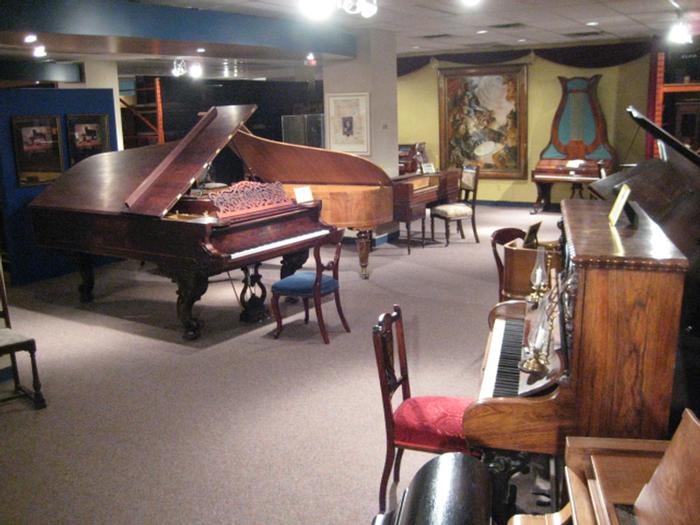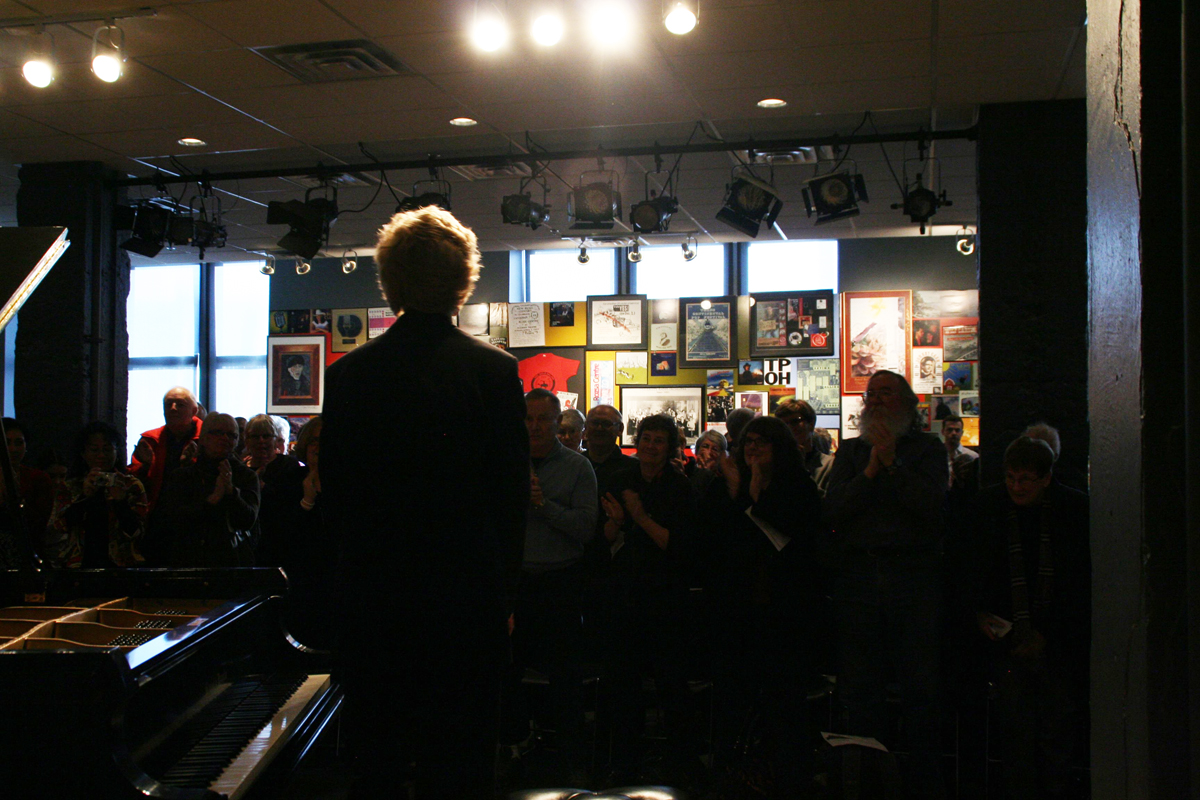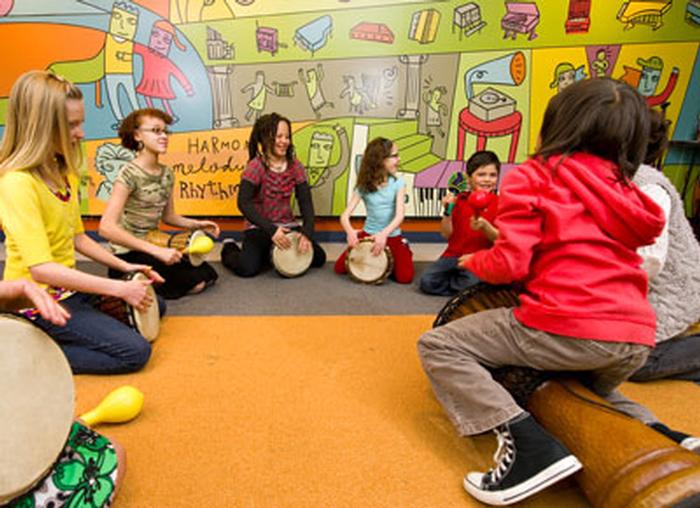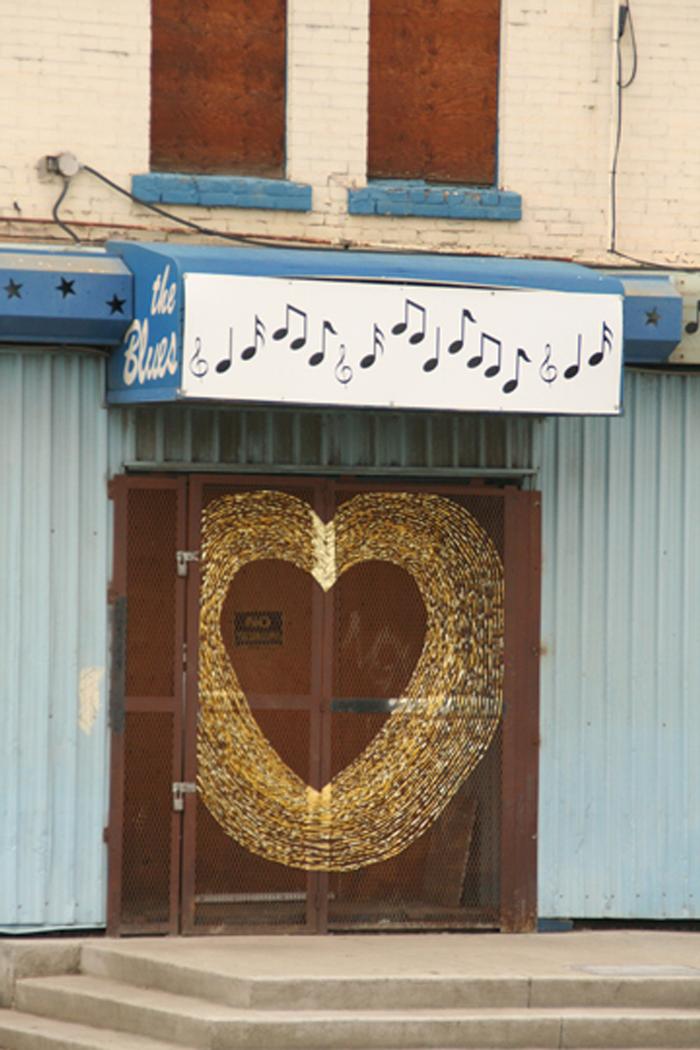[ID:71] Museum of Music Moves a CityCanada A note rings and another follows. Melody floods the space. I feel the vibration of sound as it passes through me. For a moment it is only the music and myself. Then I remember the instrument, the musician, and the others around me who hear it too. Stillness returns to the room, protected from the ubiquitous whirring of the world outside.
The corridor is narrow with keyboard instruments of all shapes and sizes lining our path. Our attention moves from one instrument to the next in a chronological sequence from the Renaissance to today. We hear a Harpsichord from 1591, a nineteenth century Dulcimer from Asia and a song-writing piano that belonged to Elton John. Unlike other museums, these artifacts aren’t behind glass. Our interpreter is a professional musician and demonstrates for us what the instruments are capable of. It’s a room of musical curiosities available to listen to, touch, play and admire.
This is the Cantos Music Foundation, a sacred space in Calgary, Alberta, Canada. It is a museum of keyboard instruments, a space for performance and education centered on musical history, creation and appreciation. Music is universal; it transcends language and cultural differences. Cantos enables engagement with this art form which enriches our lives and reminds us of our shared humanity; it is a sacred space.
At some point in our lives, we have all been moved by a piece of music. We have envied a musician’s talent, marveled at the craft of an instrument or felt insignificant within a vast concert hall. The power and possibilities of music are evident at Cantos; its instrument collection is fertile ground. In conversation with Andrew Mosker, President and CEO of Cantos, he says the artifacts have become “a springboard for creativity and education, making the collection come alive.” (Mosker) The collection is one of a kind in Canada. Founded in 2003, the Cantos Music Foundation has almost two thousand musical artifacts including one of the largest collections of keyboard instruments in the world, vintage recording equipment and the latest technology in recording and sound synthesis. (Cantos)
Cantos is situated at the fringe of the commercial core where it meets the neglected South East portion of downtown. It occupies one and a half floors of a four-story sandstone and brick heritage building (built in 1916). The neighbours are blocks of parking lots, homeless people lining up at the shelter around the corner and new condominium towers hoping to capitalize on gentrification at some later date.
Today’s North American city epitomizes our fast-paced consumerist society, and Calgary is no exception to this trend. Displacing traditional ideas about ‘sacred’, Cantos augments the role of the church in the urban fabric. It responds to a contemporary way of life and its sacred qualities are emphasized by simple values. You can enter for free, join others or go alone, experience or create, escape your hectic life and take refuge in music.
This place is a haven that aids in the reconnection of our fragmented communities. Philip Sheldrake, author of the article Soul-Searching Cities: Sacred Spaces explains this reconnection, “Sacred spaces may both provoke a sense of what we lack yet evoke possibility and hope. They can assist the re-enchantment of urban existence and liberate people from a sense of fundamental estrangement.” (Sheldrake, 52) He argues that what is holy is actually whole, suggesting that Cantos’ integrated approach to the community makes it sacred.
The sacred value of Cantos is expressed through the power of music to inspire the whole in us. To be able to express ourselves is to be able to understand ourselves and to actively participate in the world around us. David Tame in his book, The Secret Power of Music asserts that, “It has been easy for modern man, born and raised within a society permeated with the philosophy of materialism and reductionism, to fall into the trap of regarding music to be a non-essential and even peripheral aspect of human life.” (Tame, 13) On the contrary to this commonly held point of view that Tame warns of, Music is fundamental. It permeates our ethnic histories and daily dose of popular culture.
Music allows people to share a fleeting moment, mutually captivated. Few aspects of our contemporary model of living can make us pause. This is something that museums generally aspire to as Sheldrake points out, “[They are] powerful symbols of the community’s creativity, aspirations and the quest for self-transcendence. [Museums are] a kind of sanctuary from the pace of city life – spaces for silence, thinking, even a kind of healing. Yet they also offer the possibility of shared contemplation with strangers.” (Sheldrake, 53) Cantos takes this further by enabling an architectural space that encourages participation and mutual learning in a way that a traditional didactic museum rarely manages. Sheldrake also describes how at Cantos music evokes our curious nature about culture, history and innovation. Barriers between us are minimized as we experience in music something greater than ourselves, something sacred.
Music changes us, shapes who we are and how we feel. In ancient times there was an understanding of a primal vibration from which music comes. “[Music was] thought to be intimately related in some way to non-physical and sacred dimensions or planes of existence,” David Tame explains (Tame, 22). The human body resonates sound. Instruments are tools and catalysts for this delightful reaction that creates music to inspire or move us in some unexpected way. Frank Lloyd Wright said this about music, “To my young mind music spoke a language that stirred me strangely and, as I have learned, music is the language beyond all words – of the human heart,” (Lucas, 3) Music affects us deeply and we have learned to express our deepest emotions through this language.
We experience music in simple but profound ways. During a concert a few years ago, I was sitting close to the stage in the Music Room at Cantos. The artist was Canadian singer and songwriter, Jill Barber, accompanied by another musician. There were two guitars and a gleaming grand piano. Her voice blended beautifully with the sound of the instruments. It amazed me that from this petite young woman came a powerful and captivating voice. I was so close to her soulful talent I could dream it was my own. The sound completely filled me as if my body was a receiver.
Despite age or ethnic background, music communicates to us all. For example, children from all demographics are engaged in music programs at Cantos. The Discovery Room is a brightly painted classroom with a table that can be configured into one large working surface or many small ones. Children learn math and science through music. They also learn about the history of music and participate in making music together on synthesizers and in drum circles. Cantos highlights the importance of the whole spectrum in shaping the musical landscape an issue that resonates with children and adults alike.
Being from a young country like Canada, the sacred history of the collection was not lost on me. On my first visit to Cantos, the visual impact of the history in the room is apparent even before the instruments are played. Early classical music and its elaborate instruments, the development of rock and roll and the democratic implications of electronic music send a strong message of how our culture has changed throughout the centuries. The creation of music has passed from the elite to the masses who not only make music but the tools as well.
Direct contact with the tools of music adds to Cantos’ sacred value. As a visitor you can stand right beside the instruments, run your finger tips across perfectly smooth surfaces, and watch the tiny parts move up and down like a tiny city in perfect harmonious motion. Imagine, for example, the Hungarian Cimbalom Dulcimer (of Iranian origin). It is like an open piano played by striking the strings with beaters, this one from 1905. An accordion from the 1930’s expands and contracts, the air and energy pushing out the sound. An early drum machine from Japan built in 1981 is curious as both a synthetic representation of an ancient instrument and grandfather of Hip Hop. The Theremin is one of the biggest surprises. It is a rare instrument you play without touching. Developed in 1928 by a Russian named Leon Theremin two antennas create an electromagnetic field, which creates music when altered by the movement of your hand. (Cantos) An understanding of these instruments and the opportunity to play them, reminds us of how music relates to our bodies, human ingenuity and building.
Are instruments like buildings or buildings like instruments? In a musical instrument humanity is represented as a soulful vibration flowing through it. Energy and active participation by people are needed to make them work. The architecture of Cantos must balance form and function, with elegance and harmony as the result.
Presently, Cantos lives in a dramatically under-serving architectural space. There is nothing particularly suitable about it from a technical point of view, other than how they have clad the walls with sound absorbing panels in the museum and built a modest low stage in the performance space. The ceiling in the museum is low and feels boxed in. The Music Room is a large cube with two columns piercing the middle of the audience area. The exterior has few visual keys and unsuspecting passersby would not suspect the treasures that lie within. The architecture falls short when compared to the intrigue.
Cantos is so dear to the hearts of its citizens that the community has made it a priority to ensure this museum is housed in an appropriate space. They have been fundraising for a major move to the historic King Edward Hotel, built in 1905, known locally as the ‘King Eddy’. They will expand to incorporate a new contemporary museum with performance spaces, a creative incubator and educational facilities under the new name of National Music Center. The King Eddy will become a jewel in their collection. (Mosker)
The King Eddy is said to be Canada’s first blues bar as well as the first desegregated bar in the country. Blues greats Muddy Waters and B.B. King played there. In the last two decades the hotel and its immediate neighbourhood on the east side of the downtown have fallen into ruin. When the bar was condemned in 2004, there was an outcry from the community to find a way to preserve it for its embedded musical stories. The relocation of Cantos to this neighbourhood is the first major catalyst in many years and resurrects excitement and pride about this young city’s musical history. (Cantos)
Cantos’ success in building community around our shared history is a result of blurring the hierarchy between performers and audiences, teaching and learning. Barry Blesser and Linda-Ruth Salter elaborate on this idea in, Spaces Speak, Are You Listening? by saying, “In the distant past… music was a communal activity in a shared environment; everyone participated without a clear distinction between active performers and passive listeners.” (Blesser and Salter, 129) Any purpose built architecture for this sacred space should include informal spaces where the audience can be close to or part of the performance, which is a penchant to its sacred qualities today.
Access and approachability are critical strengths of Cantos. Chamber musicians to local alternative garage bands take advantage of its affordable space. Non-profit and for-profit events of all kinds happen here on any given night allowing for a cross section of people to enter the space. The architecture of a performance and community space like this should remain intimate and accessible in cost, scale and materials.
The design of musical instruments is a reflection of human ingenuity and craft. They demonstrate form following function in the most elegant way. Frank Lloyd Wright comments on the connection between architects and musicians that are useful in looking at the architecture of Cantos, "The striving for entity, oneness in diversity, depth in design, repose in the final expression of the whole - all these are there in common pattern between architect and musician. " (Lucas, 4) The new building to be built (designed by Allied Works Architecture and BKDI) is based on the design of musical instruments. Mosker explains, “The building is a resonant vessel that gets played by the people. The building is a musical instrument.” The new building will contribute to the city and country’s cumulative musical histories and Mosker explained that Canada has not been particularly good at telling its own musical history. (Mosker)
Cantos’ ability to translate the sacred value of its current location into new architecture will be a critical step. Large institutions can be intimidating and museums can suffer a loss in engagement when artifacts must be protected. One of the greatest strengths of this current sacred space is the access to the instruments and the intimacy of the spaces. Therefore in any future spaces, intimate interaction with music as well as large spaces that humble us must be included. Cantos has already raised the over all value of music in our lives. This truth must be made explicit through architecture.
The preservation and encouragement of Cantos as a sacred space is of utmost importance. It takes the continual engagement, investment and participation of the broader public so that Cantos can continue to contribute to the development of music in our community. Cantos has preserved a very unique musical environment, made waves in education through music and kept its doors open to all types of community groups. This authentic and holistic approach to music in Calgary ensures that this sacred space thrives.
Architectural changes for the future of Cantos should make explicit its responsiveness to the community. This will ensure the architecture expresses its inherent value as social art. Cantos’ programs and space dissolve the barriers between classical and pop music, teacher and student, performer and listener. We come together to contribute to our collective memory within music as it precedes language and therefore our differences. It should express its unique musical character from instrument to architecture. Cantos Music Foundation is a sacred space in our community, making accessible the beautiful and binding story of music that touches all humanity.
Works Cited
Blesser, Barry and Linda-Ruth Salter. Spaces Speak, Are You Listening? Cambridge: MIT Press, 2007.
Cantos Music Foundation “Cantos Home Page.” Accessed January 10, 2011. http://www.cantos.ca/.
Lucas, Suzette, editor. “Architecture and Music.” Frank Lloyd Wright Quarterly, Spring v.9, n.2 (1998). p.3-23.
Mosker, Andrew C., President and CEO of Cantos Music Foundation, Phone Interview, January 14, 2011
Sheldrake, Philip. “Soul-Searching Cities: Sacred Spaces.” RIBA Journal 114 (2007): 52-53.
Tame, David. The Secret Power of Music. Rochester: Destiny Books, 1984.
Photo credits: Cantos Music Foundation
If you would like to contact this author, please send a request to info@berkeleyprize.org. |




